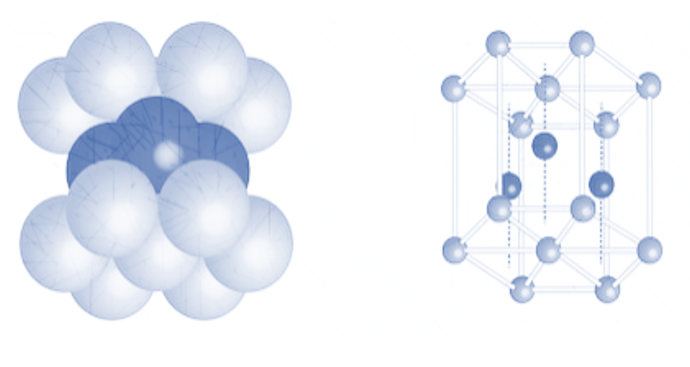
The ABAB packing and ABCABC packing are respectively called as:
A. Hexagonal close packing (hcp) and cubic close packing (CCP)
B. Cubic close packing (ccp) and hexagonal close packing (HCP)
C. Body centred cubic (bcc) and hexagonal close packing (HCP)
D. Hexagonal close packing (hcp) and body centred cubic (BCC)
Answer
162.9k+ views
Hint: The different packing structures or types can be identified on the basis of the molecular arrangement in the given lattice. Each type of packing structure has a unique arrangement of atoms within them that can be understood by viewing the lattice from a side profile.
Complete Step-by-Step answer:
The spatial arrangements of atoms within a given lattice can be done in one dimension or two dimensions or even in 3 dimensions. Cubic close packing (ccp), hexagonal close packing (hcp) and body centred cubic (bcc) are all 3-dimensional spatial arrangements.
The spatial arrangements for the given packing structures are given as follows:
1. Hexagonal close packing

The arrangement in hexagonal packing as observed above is ABABAB
2. Cubic close packing

Face centred cubic packing is also known as cubic close packing. The arrangement in hexagonal packing as observed above is ABCABC
3. Body centred cubic packing

Since the body centric atoms are not in contact with any other atom within the same 2 – dimensional layer, it cannot be defined using a layer by layer interpretation.
Hence, the ABAB packing and ABCABC packing are respectively called as hexagonal close packing (hcp) and cubic close packing (ccp)
Hence, Option A is the correct option.
Note: The repetitive patterns of the different 2 - dimensional layers of the packing structures are named A, B, C and so on. So, each type of dimensional packing structure, has its own repetitive arrangements of the 2 - dimensional layers which can be represented in the above fashion.
Complete Step-by-Step answer:
The spatial arrangements of atoms within a given lattice can be done in one dimension or two dimensions or even in 3 dimensions. Cubic close packing (ccp), hexagonal close packing (hcp) and body centred cubic (bcc) are all 3-dimensional spatial arrangements.
The spatial arrangements for the given packing structures are given as follows:
1. Hexagonal close packing

The arrangement in hexagonal packing as observed above is ABABAB
2. Cubic close packing

Face centred cubic packing is also known as cubic close packing. The arrangement in hexagonal packing as observed above is ABCABC
3. Body centred cubic packing

Since the body centric atoms are not in contact with any other atom within the same 2 – dimensional layer, it cannot be defined using a layer by layer interpretation.
Hence, the ABAB packing and ABCABC packing are respectively called as hexagonal close packing (hcp) and cubic close packing (ccp)
Hence, Option A is the correct option.
Note: The repetitive patterns of the different 2 - dimensional layers of the packing structures are named A, B, C and so on. So, each type of dimensional packing structure, has its own repetitive arrangements of the 2 - dimensional layers which can be represented in the above fashion.
Recently Updated Pages
JEE Atomic Structure and Chemical Bonding important Concepts and Tips

JEE Amino Acids and Peptides Important Concepts and Tips for Exam Preparation

JEE Electricity and Magnetism Important Concepts and Tips for Exam Preparation

Chemical Properties of Hydrogen - Important Concepts for JEE Exam Preparation

JEE Energetics Important Concepts and Tips for Exam Preparation

JEE Isolation, Preparation and Properties of Non-metals Important Concepts and Tips for Exam Preparation

Trending doubts
JEE Main 2025 Session 2: Application Form (Out), Exam Dates (Released), Eligibility, & More

JEE Main 2025: Derivation of Equation of Trajectory in Physics

Displacement-Time Graph and Velocity-Time Graph for JEE

Types of Solutions

Degree of Dissociation and Its Formula With Solved Example for JEE

Electric Field Due to Uniformly Charged Ring for JEE Main 2025 - Formula and Derivation

Other Pages
NCERT Solutions for Class 12 Chemistry Chapter 1 Solutions

JEE Advanced Marks vs Ranks 2025: Understanding Category-wise Qualifying Marks and Previous Year Cut-offs

Solutions Class 12 Notes: CBSE Chemistry Chapter 1

NCERT Solutions for Class 12 Chemistry Chapter 6 Haloalkanes and Haloarenes

NCERT Solutions for Class 12 Chemistry Chapter 2 Electrochemistry

Electrochemistry Class 12 Notes: CBSE Chemistry Chapter 2




